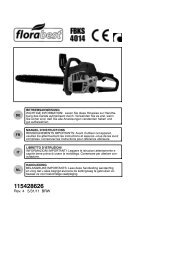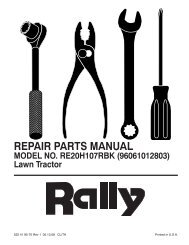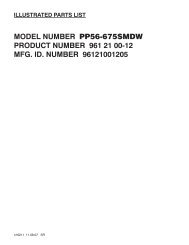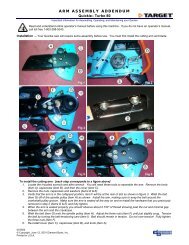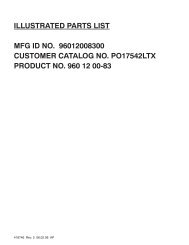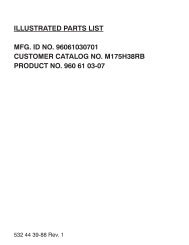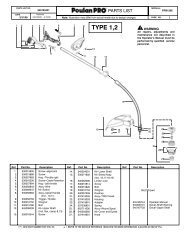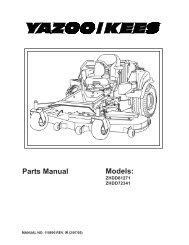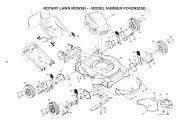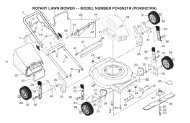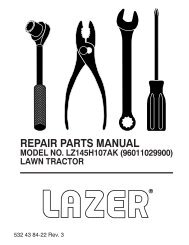OM, Soff-Cut 4200, 2010-01, EN - Klippo
OM, Soff-Cut 4200, 2010-01, EN - Klippo
OM, Soff-Cut 4200, 2010-01, EN - Klippo
Create successful ePaper yourself
Turn your PDF publications into a flip-book with our unique Google optimized e-Paper software.
GB<br />
Operator’s manual<br />
<strong>Soff</strong>-<strong>Cut</strong> <strong>4200</strong><br />
Please read the operator’s manual carefully and make sure you<br />
understand the instructions before using the machine.<br />
HUSQVARNA CONSTRUCTION PRODUCTS
Content<br />
CONT<strong>EN</strong>TS<br />
Page<br />
Table of contents ………………………….. 2<br />
Unpacking .................................................. 2<br />
Transporting ............................................... 2<br />
Sound Data ................................................ 2<br />
Introduction, personal safety ...................... 3<br />
Registration of the product ………………… 4<br />
General safety message ............................ 4<br />
Safety warnings ......................................... 5<br />
Excel series blades ................................... 6<br />
Blade and skid plate installation ................ 6<br />
What is what? ............................................ 7<br />
Operating instructions ............................... 8-9<br />
Fuel and fuel safety warnings …….…….... 10<br />
Recommended fuels ................................. 10<br />
Recommended oils …….......……….…..… 10<br />
Engine and transmission maintenance ..... 11<br />
Other maintenance ………………….…….. 12<br />
Sawing contraction joints …………....….… 13<br />
Maximizing the <strong>Soff</strong>-<strong>Cut</strong> system .......…..... 14<br />
Troubleshooting ......................................... 15<br />
Your <strong>4200</strong> saw has been shipped from the factory thoroughly<br />
inspected. Only minimal assembly is required to start using<br />
the saw. Remove the saw from the container using proper lifting<br />
techniques. Discard or recycle the packing material per<br />
your regional laws. In your container will be the <strong>4200</strong> saw,<br />
diamond blade, skid plate, blade shaft wrench, spark plug<br />
wrench, an owner’s manual, an engine owner’s manual, a part<br />
list, a warranty card, a joint protector sample pack and a ramp<br />
for unloading the saw. Connect the battery cables and turn the<br />
key switch to the “ON” or “1” position on the instrument panel.<br />
Press the rocker switch on the instrument panel to raise the<br />
saw. Place the unloading ramp at the edge of the container<br />
and roll the saw out of the container. Lower the saw and turn<br />
the key switch to the “OFF” or “0” position.<br />
The <strong>4200</strong> saw weights approximately 496 pounds (225 kilograms)<br />
when ready to use . Use safe lifting practices when<br />
handling the saw. Always remove the diamond blade when<br />
transporting the saw. Always transport the saw with a skid<br />
plate installed. Retract the guide arm. The saw can be lifted<br />
from the side and front handles or using the optional lifting kit<br />
and sling. Always store and transport the saw in a completely<br />
lowered position and secured from moving.<br />
Instrument<br />
panel<br />
UNPACKING<br />
TRANSPORTING<br />
Lifting point<br />
Hood<br />
Lifting point<br />
Technical specifications ............................. 16<br />
Conformity certificates ............................... 16<br />
Warranty .................................................... 17<br />
Front guide<br />
Lifting point<br />
CAUTION<br />
Only use the side and front lifting<br />
handles when lifting the <strong>4200</strong>.<br />
2
INTRODUCTION<br />
The <strong>4200</strong> is designed as a heavy duty commercial, industrial, and paving Ultra Early Entry concrete<br />
saw. The patented <strong>Soff</strong>-<strong>Cut</strong> Ultra Early Entry dry cutting system controls random cracking of concrete<br />
through the early timing of the saw cutting usually within one to two hours after finishing process is completed.<br />
The patented low noise and low dust blade block and skid plate technology in conjunction with the<br />
Husqvarna blades allows for Ultra Early Entry sawing the same day while minimizing chipping and spalling.<br />
The saw is a self-propelled style with electric switch controls for all functions and electric start.<br />
Common sense:<br />
The focus of this manual is HOW to operate and service the equipment safely.<br />
It is not possible to cover every conceivable situation you can face when using this equipment. Therefore use this<br />
product only in a manner described in this manual. Operation or handling the machine in any other manner can<br />
lead to serious injury or death.<br />
If a situation is not described in this manual it should be considered dangerous - and not be done.<br />
If you are unfamiliar with this product make sure that you carefully understand how it functions and practice all<br />
operations and handling before putting the machine to use. Familiarize yourself in the presence of an experienced<br />
operator. Avoid all situations that are beyond your capability.<br />
If you still feel uncertain about the operating procedures after reading these instructions DO NOT operate the<br />
machine until you have consulted an experienced operator.<br />
If you have further questions you can contact the closest Husqvarna Construction Products location by writing or<br />
calling, see information below. You can also find the closest location by searching the internet at;<br />
www.husqvarnacp.com . Husqvarna Construction Products will willingly be of service and provide you with advice<br />
as well as help you to use your product both efficiently and safely.<br />
Additional manuals are available at NO CHARGE and can also be obtained on the internet site.<br />
Husqvarna Construction Products<br />
265 Radio Road<br />
Corona, California 92879<br />
USA<br />
Toll Free no: 800 776 3328 (USA & Canada)<br />
Phone no: 951 272 2330<br />
Telefax no: 951 272 2338<br />
Internet Site: www.husqvarnacp.com<br />
PERSONAL SAFETY EQUIPM<strong>EN</strong>T<br />
When working and operating the saw the following<br />
approved personal safety items should be used:<br />
Head<br />
Protection<br />
Hearing<br />
Protection<br />
Eye<br />
Protection<br />
Safety<br />
Shoes<br />
Protective<br />
Gloves<br />
3
REGISTER THE PRODUCT<br />
Please register your new <strong>4200</strong> with Husqvarna Construction Products by mailing<br />
in the registration card that came with the machine or you can register on the internet site<br />
www.husqvarnawarranty.com<br />
Registration will allow us to contact in case of any critical updates or recalls on this machine.<br />
Warranty registration has also been found to be helpful in tracing stolen equipment.<br />
Record the following information for your records:<br />
PURCHASE DATE: ________________<br />
MODEL No: ________________<br />
SERIAL No: __________________<br />
<strong>EN</strong>GINE MODEL: _____________ <strong>EN</strong>GINE TYPE: ______________<br />
<strong>EN</strong>GINE CODE: ________________<br />
The <strong>4200</strong> model and serial number as well as the engine model number, engine type and code are critical in order<br />
to obtain the correct service parts.<br />
SAFETY DEFINITIONS<br />
In this manual a Safety Alert Symbol followed by the signal words WARNING and CAUTION are used to<br />
identify safety information about hazards which can result in death, serious injury and/or property damage.<br />
These signal words mean:<br />
WARNING indicates a hazard which, if not avoided, could result in death or serious injury.<br />
CAUTION indicates a hazard which, if not avoided, might result in minor or moderate injury.<br />
NOTICE indicates a message not related to personal injury.<br />
SAFETY HAZARDS<br />
WARNING<br />
DO NOT MODIFY THE PRODUCT<br />
Under no circumstances may the design of the machine be modified without the permission of the manufacturer.<br />
Always use genuine accessories. Unauthorized modifications and/or accessories can result in<br />
serious personal injury or the death of the operator or others. Your warranty may not cover damage or<br />
liability caused by the use of unauthorized accessories or replacement parts.<br />
WARNING<br />
ASPHYXIATION HAZARD<br />
Running an engine in a confined<br />
or badly ventilated area<br />
can result in injury or death due<br />
to asphyxiation or carbon<br />
monoxide poisoning.<br />
WARNING<br />
CALIFORNIA PROP 65<br />
Use of this product can expose<br />
you to materials known to the<br />
State of California to cause<br />
cancer and/or birth defects or<br />
other reproductive harm.<br />
CAUTION<br />
HEARING HAZARD<br />
During the normal use of this<br />
machine, operator may be<br />
exposed to a noise level equal<br />
to or higher than 85 dB(A). Use<br />
hearing protection.<br />
4
WARNING<br />
SAFETY WARNINGS<br />
SAW SAFETY<br />
• Do not leave saw unattended while the engine is running.<br />
Failure to comply with the following warnings could<br />
result in serious bodily injury or death!<br />
PERSONAL SAFETY<br />
• Read and understand instructions before operating saw.<br />
• Always wear safety approved hearing, eye, head and<br />
respiratory protection.<br />
• Wear boots with non-slip soles to provide proper footing.<br />
Steel-toed safety boots are recommended.<br />
• Wear rubber work gloves to avoid contact with wet concrete<br />
which can cause serious skin irritation.<br />
• Know how to stop the saw quickly in case of emergency.<br />
• Keep all parts of your body away from blade and other<br />
moving parts. Do not wear loose clothing or jewelry which<br />
can be caught in moving parts. Wear protective hair covering<br />
to contain long hair.<br />
• Use caution when loading and unloading saw.<br />
• Stay alert. Maintain awareness of saw operation. Use<br />
common sense. Do not operate saw when tired or after<br />
consumption of any substance that would impair physical<br />
function or rational judgment.<br />
• Do not over reach. Keep proper footing and balance.<br />
WORK AREA SAFETY<br />
• Never operate the saw in any application or job where you<br />
are not trained or supervised.<br />
• Keep visitors, children and animals out of the work area.<br />
• Observe all safety regulations for the safe handling of fuel.<br />
Gasoline is extremely flammable and its vapors can explode<br />
if ignited. Do not refuel indoors or in poorly ventilated areas.<br />
Handle fuel in safety containers. Shut off the engine and<br />
allow it to cool before refueling. Wipe the saw dry if fuel is<br />
spilled on it. Always move away from the fueling area before<br />
starting the engine. Do not smoke while refueling.<br />
• Do not operate the saw while smoking or near an open flame.<br />
• Do not operate the saw in areas of combustible material or<br />
fumes. Sparks may occur from the saw that could cause a<br />
fire or explosion.<br />
• Operate only in well ventilated areas. Engine exhaust contain<br />
carbon monoxide which can cause loss of consciousness and<br />
possible death.<br />
• The muffler and engine become very hot during operation.<br />
Keep all body parts and foreign material away from the<br />
engine while running.<br />
• Avoid dangerous environments. Do not expose saw to rain.<br />
Keep work area well lit and clean.<br />
• Do not alter the saw. Any alteration or modification is misuse<br />
and may result in a dangerous condition.<br />
• All safety guards must be in place before starting the engine.<br />
• Only operate the saw from behind the machine with both<br />
hands on the handle.<br />
• Do not use damaged equipment, blades, guards or personal<br />
protection equipment. Do not disable safety equipment or kill<br />
switches.<br />
• Do not operate the saw if there is a fuel leak.<br />
• Use extreme caution when maneuvering the saw on ramps<br />
or loading and unloading from trucks or trailers.<br />
• Use only Husqvarna Construction Products replacement<br />
parts. Use of unauthorized parts may create a danger.<br />
• Do not use the saw as vehicle for transporting personnel or<br />
equipment.<br />
• Remove the ignition cable from the spark plug before<br />
performing saw maintenance or changing blades to prevent<br />
accidental engine starting.<br />
• Remove all wrenches from the saw before starting.<br />
• Never stand on the saw.<br />
• When the saw is not in use or transporting, remove the blade<br />
and lower the saw completely. Properly secure the saw to<br />
prevent accidental movement.<br />
BLADE SAFETY<br />
• Examine cutting blades before each use. Do not use any<br />
blades that has cracks, nicks, or flaws. Tri-arbor hole should<br />
be undamaged. Use only dry cut, steel centered, tri-arbor<br />
diamond blades made for cutting green concrete.<br />
• Husqvarna Excel Series diamond blades are designed to<br />
only cut green concrete. <strong>Cut</strong>ting any other material may result<br />
in blade failure or a dangerous condition.<br />
• Inspect blade flanges for damage, excessive wear and<br />
cleanliness before mounting the blade. The blade should fit<br />
snugly on clean, undamaged, tri-arbor shaft.<br />
• Use only Husqvarna Excel Series blades or blades marked<br />
with a maximum operating speed greater than 3500 rpm.<br />
• Never operate the saw without the blade block assembly<br />
securely in place including blade cover, lexan shields and<br />
skid plate installed in working order. A damaged blade block<br />
assembly must be replaced to protect the operator.<br />
• Make sure the blade does not make contact with the ground<br />
or any other surface when maneuvering the saw.<br />
• Avoid getting in direct line with the blade or contacting the<br />
blade while it is rotating.<br />
5
EXCEL SERIES BLADES<br />
The Excel Series of diamond blades have been designed specifically for the <strong>Soff</strong>-<strong>Cut</strong> Ultra Early Entry dry cutting system of<br />
green concrete. These specialty blades are designed to increase speed and life while cutting a wide range of aggregates.<br />
Choose the correct specification of diamond blade for your area as follows:<br />
Purple Excel Series 1000 XL14-1000 Ultra hard aggregate and non abrasive sand<br />
Green Excel Series 2000 XL14-2000 Hard to ultra hard aggregate and non abrasive sand<br />
Red Excel Series 3000 XL14-3000 Hard aggregate, medium abrasive sand<br />
Orange Excel Series 4000 XL14-4000 Medium hard aggregate, medium abrasive sand<br />
Yellow Excel Series 5000 XL14-5000 Medium hard to soft aggregate, abrasive sand<br />
Black Excel Series 6000 XL14-6000 Soft aggregate, highly abrasive sand<br />
BLADE AND SKID PLATE INSTALLATION<br />
Step 1<br />
Turn the key switch (located on the instrument panel) to the<br />
“ON” or “1” position. Press the blade depth rocker switch in the<br />
instrument panel to raise the saw to its full height. Turn the key<br />
to the “OFF” or “0” position.<br />
Step 2<br />
Remove the blade block cover (A) by turning the two locking<br />
knobs counter-clockwise. Insert the blade wrench supplied<br />
with the saw on the blade shaft bolt (B) on the end of the blade<br />
shaft in the blade block (C). Rotate the blade shaft counterclockwise<br />
with the wrench on the blade shaft bolt (C) while<br />
pushing in on the blade shaft locking pin (D) located on the<br />
front of the saw frame. The locking pin will drop in the blade<br />
shaft and prevent the shaft from rotating.<br />
Step 3<br />
Remove the blade shaft bolt by continuing to turn the bolt<br />
counter-clockwise. Remove the outer arbor washer or flange<br />
(E).<br />
WARNING<br />
Inspect the blade (K) for any damage. Do not use any<br />
blade that has cracks, nicks, flaws or a damaged arbor.<br />
Make sure the blade is marked with a maximum operating<br />
speed greater than 3500 rpm.<br />
Step 4<br />
Match the blade tri-arbor to the blade shaft arbor (F) and install<br />
the blade firmly against the rear flange (F). Insure the blade is<br />
installed on the tri-arbor correctly. Match the female tri-arbor of<br />
the outer washer or flange with the blade shaft and install the<br />
blade shaft bolt turning clockwise while holding the locking pin<br />
in. Be sure the outer flange is fully seated and firmly holding<br />
the diamond blade in position.<br />
Step 5<br />
Install a new skid plate (G) by hooking the front on the front<br />
blade block shaft pin. Connect the rear blade block shaft and<br />
the rear of the skid plate by installing the locking pin.<br />
Step 6<br />
Install the blade cover by turning the two knobs and tighten until<br />
fully seated against the blade block. Lift the front and rear of<br />
the skid plate to insure the blade slides through the skid plate<br />
freely.<br />
Step 7<br />
Insure the lexan shields (H & I) move freely up and down.<br />
When replacing a worn blade, thoroughly clean the concrete<br />
from blade block and blade cover before installing the new<br />
blade. Discard the old skid plate and replace it with a new skid<br />
plate.<br />
NOTE:<br />
The patented skid plate is the most important part of the<br />
<strong>Soff</strong>-<strong>Cut</strong> Ultra Early Entry system. If it is bent, twisted or<br />
damaged, spalling and raveling of a cut may result. Store<br />
skid plates carefully and install them properly. Install a<br />
new skid plate with each new blade. Never re-use skid<br />
plates.<br />
A<br />
C<br />
B<br />
H<br />
E<br />
K<br />
F<br />
I<br />
D<br />
6<br />
G
WHAT IS WHAT<br />
A<br />
B<br />
C<br />
D<br />
P<br />
Q<br />
G<br />
H<br />
I<br />
J<br />
K<br />
L<br />
M<br />
N<br />
O<br />
E<br />
F<br />
W<br />
V<br />
T<br />
S<br />
R<br />
U<br />
What is what?<br />
A. Choke<br />
B. Circuit breaker<br />
C. Engine on/off switch<br />
D. Emergency stop switch<br />
E. Tachometer<br />
F. Hour meter/Volt meter<br />
G. Saw forward speed switch<br />
H. Guide switch<br />
I. Engine speed switch<br />
J. Transmission neutral light<br />
K. Digital display<br />
L. Engine oil alert light<br />
M. Light switch<br />
N. Handle bar height switch<br />
O. Blade depth switch<br />
P. Fuel cap/gauge<br />
Q. Hood<br />
R. Blade block<br />
S. <strong>Cut</strong> depth pointer<br />
T. Side light<br />
U. Rear guide<br />
V. Lifting handle<br />
W. Rear access panel<br />
X. Battery<br />
Y. Oil dipstick<br />
Z. Oil fill cap<br />
Y<br />
Model number and serial<br />
number<br />
Z<br />
X<br />
7
OPERATING INSTRUCTIONS<br />
Control panel<br />
Hood<br />
To start the engine, turn the key switch (C) to the “ON” or “1”<br />
position to activate the rocker switches. Raise the saw by<br />
pushing the blade rocker switch (O) on the instrument panel to<br />
the full up position. Push the saw forward speed rocker switch<br />
(G) into neutral indicated by the red light (J) on the instrument<br />
panel. Make sure the red emergency stop button (D) is in the<br />
“up” position. The saw will not start unless the emergency<br />
stop is “up”.<br />
Close the engine choke (A) by pulling up on the knob. The<br />
closed choke position enriches the fuel mixture for starting a<br />
cold engine. The open choke position provides the correct fuel<br />
mixture for operation after the engine starts and for restarting<br />
a warm engine. Start the engine by turning the key switch (C)<br />
to “START” or “2” position and release once the engine starts.<br />
Slowly open the choke (A) by pushing down on the knob. Allow<br />
the engine to warm for a few minutes.<br />
Rear guide<br />
Blade block<br />
NOTE:<br />
The hour meter (F) runs when the key is “ON” even if the<br />
motor is not running.<br />
Experience is very important when running the <strong>4200</strong> saw. A<br />
skilled worker is highly recommended. Always do an inspection<br />
of the saw before starting the engine. Check the fuel (P) and<br />
oil level (Y) per the enclosed engine manual. SAE 10W/30 oil<br />
and unleaded gasoline with an 87 or higher octane should be<br />
used. The hydrostatic tansmission use Mobil DTE 26 hydraulic<br />
oil or equivalent (20W with viscosity of 68). Observe all safety<br />
regulations for the safe handling of fuel. Always check the<br />
engine oil with the saw turned off, completely lowered and<br />
the engine level! Check that all controls are in good working<br />
order. Check for loose bolts or nuts. Check for fuel or oil<br />
leaks. Insure all guards are secure, undamaged and properly<br />
installed.<br />
WARNING<br />
Front guide wheel<br />
WARNING<br />
ASPHYXIATION HAZARD<br />
Running an engine in a confined or badly ventilated<br />
area can result in injury or death due to asphyxiation<br />
or carbon monoxide poisoning.<br />
Open the engine throttle lever to full open position for maximum<br />
engine speed by pushing the engine speed rocker switch<br />
(I). Lower the front guide to the full down position by depressing<br />
the guide arm rocker switch (H).<br />
Line up the saw with the cut line using the front guide wheel,<br />
the rear guide (U), and the triangle pointer on the back of the<br />
blade block. Press the blade rocker switch (O) to lower the<br />
blade in the concrete slowly to the desired depth (S) shown on<br />
the back of of the blade block.<br />
Do not operate saw if there is a fuel leak!<br />
WARNING<br />
Do not operate the saw unless all guards, safety<br />
equipment and the engine kill switch are in place and<br />
operational!<br />
Check the air filter and clean or replace if necessary. Check<br />
for proper specification of blade and that the skid plate operates<br />
properly. Check that the blade and skid plate are in good<br />
condition. Make sure the work site is clean, well lit and hazard<br />
free.<br />
Move the saw forward by tapping the forward speed rocker<br />
switch (G) until the desired cutting speed is reached. Keep the<br />
front guide wheel on the cut line to insure straight cuts. Make<br />
small adjustments by applying side pressure on the handle to<br />
keep the saw straight.<br />
Move the saw at about half speed for the first 200 feet to allow<br />
the blade to develop good diamond exposure or open up<br />
and promote full blade life. Increase the forward speed of the<br />
saw until the blade and the engine are working at maximum<br />
efficiency.<br />
8
cont...<br />
Increase the forward speed if the saw is pulling left. Decrease<br />
the forward speed if the saw is pulling right. Do not force the<br />
saw. When approaching a wall, raise the front guide and use<br />
the triangle guide at the back of the blade block to cut the last<br />
few feet.<br />
Do not hit the blade block assembly against any object.<br />
Damage may result. Slow the forward speed by pressing the<br />
forward speed rocker switch (G) until the saw stops. Press the<br />
blade rocker switch (O) to raise the saw out of the cut to full<br />
“UP” position.<br />
DIGITAL DISPLAY (K)<br />
The digital display in the center of the instrument panel indicates<br />
the travel speed of the saw and the total distance cut<br />
by the saw. Push the left arrow button until the display shows<br />
“R” on the left of the display. The unit is set to show the travel<br />
speed of the saw in feet/minute in the US and meters/minute<br />
outside the US. Pressing the left arrow button again changes<br />
the display to the total distance cut by the saw. The R button<br />
on the right resets the cut distance to zero.<br />
The self propel function of the saw will not operate with the unit<br />
in a raised position. Press the engine speed rocker switch (I)<br />
to lower the engine speed. Turn the engine kill switch to the<br />
“OFF” or “0” position. Lower the saw to the down position.<br />
HOUR METER/VOLT METER GAUGE (F)<br />
The hour meter and volt meter are incorporated in the same<br />
gauge. With the engine running, the volt meter is operating.<br />
The gauge reads the total saw hours when the engine is not<br />
running.<br />
WARNING<br />
Do not leave the saw unattended while the engine<br />
is running! Always secure the saw from movement<br />
while unattended.<br />
NOTE:<br />
Do not walk on the joints or transport equipment across<br />
the joints until the concrete fully hardens.<br />
TACH<strong>OM</strong>ETER GAUGE (E)<br />
The tachometer gauge provides the engine speed in revolutions<br />
per minute (rpm).<br />
OIL ALERT LIGHT (L)<br />
The oil alert light indicates a drop in engine oil pressure. If the<br />
light illuminates, immediately turn the engine off. Do not use<br />
the engine if the oil alert is lit or engine damage may occur.<br />
Periodically, clean any excess concrete from inside the blade<br />
block, scrapers and blade block cover. Always clean the blade<br />
block assembly thoroughly before storing the saw.<br />
WARNING<br />
Before each use, carefully inspect the <strong>4200</strong> for any<br />
damage to any of its parts and components. Pay<br />
careful attention to any leakage of gasoline or oil.<br />
Under no circumstance should the <strong>4200</strong> or any of<br />
its attachments be operated if you find damage or<br />
are suspicious that something appears to be damaged.<br />
9
FUEL HANDLING<br />
WARNING<br />
Taking the following precautions will lessen the risk<br />
of injury and property damage:<br />
- Use extreme care in handling gasoline. It is<br />
extremely flammable and the vapors are explosive.<br />
- Extinguish all cigarettes, cigars, pipes, and other<br />
sources of ignition.<br />
- Use only approved gasoline containers.<br />
- Never remove gas cap or add fuel with the engine<br />
running. Allow engine to cool a minimum of 3<br />
minutes before refueling.<br />
- Never fuel the machine indoors.<br />
- Never store the machine or fuel container where<br />
there is an open flame, spark, or pilot light such as<br />
on a water heater or other appliances.<br />
- Never fill containers inside a vehicle or on a truck<br />
or trailer bed with a plastic liner. Always place<br />
containers on the ground away from your vehicle<br />
when filling.<br />
- Remove the <strong>4200</strong> from the truck or trailer and<br />
refuel it on the ground. If this is not possible, then<br />
refuel the equipment with a portable container,<br />
rather than from a gasoline dispenser nozzle.<br />
- Keep the nozzle in contact with the rim of the fuel<br />
tank or container opening at all times until fueling is<br />
complete. Do not use a nozzle lock-open device.<br />
- If fuel is spilled on clothing, change clothing<br />
immediately.<br />
- Never overfill fuel tank. Always wipe off any spilled<br />
fuel or oil. Replace fuel cap and tighten<br />
OIL HANDLING<br />
NOTICE<br />
Used oil is a hazardous waste product. Dispose<br />
of used oil properly. Do not discard with household<br />
waste. Check with your local authorities, service<br />
center, or dealer for safe disposal/recycling facility.<br />
<strong>EN</strong>GINE OIL<br />
Oil Recommendation<br />
The engine holds approximately 2 quart (1.9 liter) when changing<br />
oil.<br />
- Use a 4-stroke automotive detergent oil of API service class<br />
SE or higher grade.<br />
- Do not use special additives.<br />
- Choose a viscosity according to the table below.<br />
Please read the enclosed Kohler Operator’s Manual for complete<br />
oil information.<br />
PROPER FUEL<br />
The Kohler engine is certified to operate on automotive unleaded<br />
gasoline with a pump octane rating (M+R) of 87 or<br />
higher. Fuel tank capacity is 3.0 gallon (11 liter).<br />
Refuel in a well-ventilated area with the engine stopped.<br />
You may use regular unleaded gasoline containing no more<br />
than 10% ethanol (E10). Do not use gasoline containing<br />
methanol.<br />
HYDROSTATIC TRANS OIL<br />
Mobil DTE 26 hydraulic oil or equivalent (20W with viscosity<br />
of 68)<br />
Use of fuels with an ethanol content of more than 10% (E10)<br />
may cause starting and/or performance problems. It may also<br />
damage metal, rubber, and plastic parts of the fuel system, as<br />
well as posing a fire hazard.<br />
Do not use fuel that is older than 30 days. Old fuel can cause<br />
running problems as well as fuel system damage.<br />
The engine will not operate on gasoline<br />
marketed as E-85 (85% ethanol)<br />
10
Engine Oil<br />
Checking, Adding and Changing Oil<br />
Check the engine oil level (A) daily with saw fully lowered and<br />
the engine level. See the enclosed Kohler manual for more<br />
details.<br />
Use SAE 10W-30 viscosity detergent automotive type with API<br />
service class SE or higher grade oil.<br />
Note: Engine holds approximately 2 quart (1.9 liter) when<br />
changing oil and oil filter.<br />
Changing the Oil<br />
<strong>EN</strong>GINE AND TRANSMISSION MAINT<strong>EN</strong>ANCE<br />
Change oil after the first 5 to 8 hours of use.<br />
Thereafter every 50 hours.<br />
Fuel filter<br />
Inspect the fuel filter (F) every 50 hours. Replace the fuel filter<br />
annually.<br />
Air filter<br />
The air cleaner assembly (G) is a canister style that can be<br />
accessed from the rear access panel of the saw. The outer air<br />
cleaner element should be replaced every 50 hours. Refer to<br />
the supplied engine manual and the “Heavy-Duty Air Cleaner”<br />
for additional information.<br />
ADDITIONAL <strong>EN</strong>GINE INFORMATION<br />
Please see the Kohler Operator’s Manual for additional information<br />
about servicing the engine.<br />
The manual also has specific information about specifications,<br />
tune-up parts, engine warranty, emission compliance, etc.<br />
F<br />
H<br />
A<br />
E<br />
C<br />
D<br />
B<br />
G<br />
I<br />
The oil drain hose (B) is located at the front of the saw by the<br />
battery.<br />
1. With the engine OFF but still warm, pull the hose (B) down,<br />
remove the brass cap and place the end of the hose in a pan.<br />
2. On the bottom and front of the engine is the oil drain valve<br />
(C). Turn the handle until it is in line with hose which opens the<br />
flow of oil.<br />
3. Before installing new filter, lightly oil filter gasket with fresh,<br />
clean oil.<br />
4. Screw filter (D) on by hand until gasket contacts oil filter<br />
adapter. Tighten 1/2 to 3/4 turn more.<br />
5. Close the oil drain valve.<br />
4. Replace the brass cap on the oil drain hose.<br />
5. Fill the engine at the oil fill cap (E) to the “F” mark on the<br />
dipstick (A) with 2 quarts (1.9 liters) of oil.<br />
The engine is equipped with an oil pressure switch that illuminates<br />
a light on on the instrument panel if the oil pressure<br />
is to low. Do not run the engine if the oil pressure light illuminates<br />
on the intrument panel or engine damage could<br />
occur.<br />
NOTICE<br />
Used oil is a hazardous waste product. Dispose of<br />
used oil properly. Do not discard with household<br />
waste. Check with your local authorities, service<br />
center, or dealer for safe disposal/recycling facility.<br />
Transmission oil<br />
Check the transmission oil level daily. The transmission is accessible<br />
from the rear access panel of the saw. The oil reservoir<br />
(H) located on the top of the transmission has an oil level<br />
line 1/8” (3 mm) from the bottom of the reservoir to indicate the<br />
proper fluid level when cold. Use hydraulic oil 20W with viscosity<br />
of 68 Mobil DTE 26 or equivalent.<br />
Transmission neutral<br />
With the saw transmission neutral light illuminated, the saw<br />
should fully stop and not creep or move. To adjust the transmission<br />
neutral position, open the rear access panel. In the<br />
lower right hand side, turn the transmission adjustment knob<br />
(I) until the saw stops completely with the transmission neutral<br />
light illuminated.<br />
11
OTHER MAINT<strong>EN</strong>ANCE<br />
Battery<br />
The battery is maintenance free. If the battery ever requires<br />
charging, use only a voltage regulated taper current charger<br />
designed specifically for sealed lead acid gel cell batteries<br />
rated at 2 amps or less (part # 5055835<strong>01</strong>). A standard automotive,<br />
or any other type, battery charger not designed specifically<br />
for sealed gel batteries will cause permanent damage to<br />
the installed battery and void any warranty. Do not leave the<br />
ignition key in the “ON” position as this will drain the battery.<br />
WARNING<br />
- Connecting and disconnecting a battery can cause<br />
sparks and short circuits. Do not short battery terminals<br />
by allowing a wrench or any other object to<br />
contact both terminals at the same time.<br />
- A spark or flame can cause a lead acid battery to<br />
explode.<br />
- Before connecting a battery, remove metal<br />
bracelets, wristwatch bands, rings, etc. Use gloves<br />
and protective glasses or face shield when working<br />
with a battery.<br />
Saw controls<br />
Inspect all controls for proper function daily. Check all the interlocks<br />
for operation especially the red emergency stop<br />
button and engine on/off switch for proper operation.<br />
Belts<br />
Inspect the blade drive belt and transmission belt for cracks or<br />
signs of wear. The belt tension is controlled by belt tensioners<br />
and does not require adjustment. Inspect the belt tensioners<br />
for free movement up and down. Insure the belt tensioner<br />
bearings roll freely.<br />
Blade shaft bearings<br />
Lubricate the blade shaft bearings with 3 pumps of Lithium 12<br />
based grease every 50 hours.<br />
Cleaning<br />
Clean the blade block of any excess concrete build up after<br />
each use. Keep the handle bars and controls clean and dry.<br />
Immediately clean any spilled fuel from the saw. Keep all<br />
openings and slot on the saw clean open so air flows freely<br />
through the engine compartment to insure proper cooling.<br />
Eye Protection<br />
Protective Gloves<br />
Explosion Danger<br />
MAINT<strong>EN</strong>ANCE SCHEDULE<br />
Check guarding, diamond blade,<br />
skid plate, lexan covers, controls and oil levels.<br />
Daily<br />
Guards<br />
Check all guards for damage and proper function daily especially<br />
the blade block. Blade block and cover should be secure<br />
to the saw and not damaged. Lexan side covers on the blade<br />
block should move freely up and down.<br />
Diamond blade<br />
Inspect diamond blades daily for damage, cracks, secure fit<br />
to the arbor, loss of segments, warping or overheating. If any<br />
blade shows any of these problems, discard the blade and<br />
never use.<br />
Clean blade block assembly and saw.<br />
Replace air cleaner.<br />
Replace engine oil.<br />
Grease blade shaft bearings.<br />
Check blade drive belt, the transmission<br />
drive belt and belt tensioner.<br />
Replace the fuel filter.<br />
Daily<br />
Every 50 hours<br />
Every 50 hours<br />
Every 50 hours<br />
Every 50 hours<br />
Annually<br />
Skid plate<br />
Inspect the skid plate daily for damage, excessive wear in the<br />
blade slot, burrs on the concrete surface side, twisting and free<br />
movement up and down when installed on the blade block.<br />
Replace the skid plate with each new diamond blade. Never<br />
reuse the skid plates or spalling and raveling may result.<br />
WARNING<br />
Do not modify the saw! Use only Husqvarna Construction<br />
Products replacement parts. Use of unauthorized<br />
parts may create a danger or damage the engine.<br />
12
SAWING CONTRACTION JOINTS<br />
As concrete hydrates or cures and begins to set, it develops internal stresses which may cause random cracks. Random<br />
cracks cast doubt on the quality and workmanship of the concrete. Contraction joints are cut in concrete to relieve these<br />
stresses before they seek their own relief in the form of random crack. The <strong>Soff</strong>-<strong>Cut</strong> Ultra Early Entry system controls random<br />
cracking through the early timing of a saw cut at predetermined locations to create weakened planes in the concrete that<br />
subsequently crack at the bottom of the cut to relieve stress. Husqvarna sawed contraction joints should be a minimum of<br />
1/8th the concrete depth and a minimum of 1” (25mm) deep. Contraction joints should be sawn as soon as the concrete will<br />
support the weight of the saw and the operator without marking or damaging the concrete. There are many possibilities for<br />
joint layout. Joint layout should be provided, the saw contractor should submit a detailed joint layout for approval prior to cutting.<br />
Several factors affect joint spacing including:<br />
• Concrete thickness<br />
• Type, amount and location of reinforcement<br />
• Shrinkage potential of concrete-cement (type, quantity), aggregate (size, quantity, quality), water to cement ratio,<br />
admixtures, concrete temperature<br />
• Base friction<br />
• Slab restraints<br />
• Layout of foundations, racks, pits, equipment pad, trenches, etc.<br />
• Environmental factors - temperature, wind, humidity<br />
• Methods and quality of concrete curing.<br />
Generally, contraction joint patterns should divide slabs into approximate square panels per the recommended spacing<br />
shown.<br />
REC<strong>OM</strong>M<strong>EN</strong>DED CONTRACTION JOINT SPACING<br />
Concrete thickness, in. (mm)<br />
Maximum spacing, ft. (m)<br />
3.5 (90) 8 (2.4)<br />
4, 4.5 (100, 114) 10 (3.0)<br />
5, 5.5 (125, 140) 12 (3.6)<br />
6 (150) or greater 15 (4.5)<br />
At all intersecting cross cuts, install Husqvarna joint protectors at each joint to prevent joint damage. Install an additional joint<br />
protector where the right wheel will cross the joint to prevent concrete damage.<br />
13
MAXIMIZING THE SOFF-CUT SYSTEM<br />
“ The timing of concrete operations - especially finishing and jointing - is critical”, states a quote from the foreword of<br />
the American Concrete Institute (ACI) 302.1 R-96. It goes on to say that “Failure to address this issue can contribute to undesirable<br />
characteristics in the wearing surface as cracking...” (It mentions other problems).<br />
The patented <strong>Soff</strong>-<strong>Cut</strong> Ultra Early Entry system has revolutionized the method used to control random cracking. While <strong>Soff</strong>-<br />
<strong>Cut</strong> is being specified more today than ever, sometimes the ultra early-entry spec is not always followed on the job site. In<br />
order for the <strong>Soff</strong>-<strong>Cut</strong> system and an experienced Husqvarna contractor to do a satisfactory job, four components must exist<br />
to meet the “specification”:<br />
1. A <strong>Soff</strong>-<strong>Cut</strong> Ultra Early Entry dry up-cut saw<br />
2. A Husqvarna Excel Series dry-cutting diamond blade<br />
3. A Husqvarna anti-ravel skid plate installed with every new diamond blade<br />
4. An operator skilled in using the <strong>Soff</strong>-<strong>Cut</strong> Ultra Early Entry cutting system.<br />
Without this, joints can not be cut clearly enough to control random cracking before it starts, which is what the building owner<br />
is paying for.<br />
The ACI Spec 302.1R-96 says it best:<br />
“Early-entry dry-cut saws use diamond-impregnated blades and a skid plate that helps prevent spalling. Timely changing<br />
of skid plates is necessary to effectively control spalling. It is best to change skid plates in accordance with manufacturer’s<br />
recommendations...The goal of saw-cutting is to create a weakened plane as soon as the joint can be cut...The timing of the<br />
early-entry process allows joints to be in place prior to development of significant tensile stress in the concrete...”<br />
The Portland Cement Association (PCA) engineering bulletin, Concrete Floors on the ground, also states:<br />
“Proper jointing can eliminate unsightly random cracks. Aspects of joining that lead to a good job are choosing the<br />
correct type of joint for each location, establishing a good joint pattern and layout, and installing the joint at the correct time...<br />
Timing of joint sawing is critical...Lightweight, high-speed, early-cut saws have been developed to permit the joint sawing<br />
very soon after floor finishing, sometimes within 0 to 2 hours...if the cut is sawn within a few hours after the final finishing,<br />
random cracking can be controlled...”<br />
Husqvarna has the only Ultra Early Entry dry-cutting system (<strong>Soff</strong>-<strong>Cut</strong>) which controls random cracking through the early timing<br />
of the cut. With the patented <strong>Soff</strong>-<strong>Cut</strong> method, control joints are usually cut within 0 to 2 hours after the finishing process.<br />
Joint cutting should begin as soon as the concrete will support the weight of the saw and the operator at each joint location<br />
and before final set. If the joints are not being cut within this time frame then the <strong>Soff</strong>-<strong>Cut</strong> Ultra Early Entry method is not being<br />
followed and building owners are not getting what they are paying for or the finished product that they expect.<br />
We hope this information is beneficial to building owners, general contractors, concrete finishers, saw operators and the<br />
entire industry. For additional information, contact Husqvarna Construction Products at (951) 272-2330 or (800) 776-3328, or<br />
see our website www.husqvarnacp.com.<br />
14
TROUBLESHOOTING<br />
SAW IS SPALLING AND RAVELLING CUT<br />
- Check to see if the diamond blade is worn out, glazed,<br />
warped or damaged.<br />
- Insure skid plate moves freely up and down the entire shaft<br />
length without contacting the diamond blade.<br />
- Check skid plate for excessive wear or gap around the<br />
diamond blade.<br />
- Check skid plate for tension or loose mounts. Skid plates are<br />
preset at the factory.<br />
- Check bottom of skid plate for metal burrs or irregularities.<br />
- Insure skid plate is not twisted or bent.<br />
- Check lexan covers for free movement up and down.<br />
- Insure there is spring down pressure at each end of the skid<br />
plate.<br />
- Do not twist or move the saw sideways while cutting.<br />
- Check that the engine is running properly and at full throttle.<br />
- Check belt and belt idler for proper tension.<br />
- Insure the diamond blade is properly mounted and secured<br />
with clean flanges.<br />
- Insure that the diamond blade is the correct specification for<br />
your area.<br />
- Insure the slab is in clean with no debris that could raise the<br />
skid plate or saw while cutting.<br />
- Use Husqvarna joint protectors at all cut intersections.<br />
- Clean excess concrete debris from the blade block assembly.<br />
- Check that the scrapers in the blade block are not bent or<br />
binding.<br />
<strong>EN</strong>GINE WILL NOT START<br />
- Check that the red emergency stop button is pulled up.<br />
- Check if there is fuel in the tank and it is the correct fuel.<br />
Make sure there is no water in the fuel.<br />
- Check that the spark plug wires are connected to the spark<br />
plugs.<br />
- Engine is flooded. Adjust the choke per the engine owner’s<br />
manual.<br />
- Check that the air filter is not dirty or plugged.<br />
- Check the choke is in the “on” position for cold starts. Adjust<br />
the choke per the engine owner’s manual.<br />
- Check that the blade shaft rotates freely and no concrete has<br />
built up in the blade block.<br />
SAW PULLS TO ONE SIDE WHILE SAWING<br />
- Check front and rear guide is properly aligned with the center<br />
of the diamond blade.<br />
- Check to see if diamond blade is worn out, glazed, warped or<br />
damaged.<br />
- Do not twist or move the saw sideways while cutting. Make<br />
gradual changes in pressure on the handlebar to control the<br />
saw in the cut.<br />
- Insure that all wheels rolls freely and smoothly.<br />
- Do not force the saw. Allow the diamond blade to cut at its<br />
own rate of speed.<br />
- Check the skid plate for damage or burrs.<br />
- Insure both driver gears are contacting the rear wheel gears,<br />
all gears and rear wheels are clean and not damaged.<br />
- Insure that the blade block shafts are not bent or damaged.<br />
- Check that the front diverter in the blade block is not bent and<br />
the diverter legs are not contacting the concrete.<br />
<strong>EN</strong>GINE RUNS ROUGH, BACK FIRES OR CAN NOT<br />
REACH FULL SPEED<br />
- Check if there is fuel in the tank and it is the correct fuel.<br />
Make sure there is no water in the fuel.<br />
- Check that the spark plugs are clean and properly gapped.<br />
- Check that choke is in the “off” position after engine is warm.<br />
- Check that air filter is not dirty or plugged.<br />
- Check that the throttle lever is properly set.<br />
15
TECHNICAL SPECIFICATIONS<br />
Engine<br />
Model<br />
Engine oil volume,<br />
quarts/liters<br />
Gasoline tank<br />
volume, gal/liters<br />
Type<br />
Air filter<br />
Oil system<br />
Muffler<br />
Emissions<br />
Cooling<br />
Cylinder<br />
Controls<br />
Kohler Command Pro CH22S<br />
2/1.9<br />
33.0/11<br />
Weight and Dimensions<br />
Air cooled, 4-cycle, twin cylinder, hydraulic<br />
overhead valves, gasoline engine<br />
Tri phase remote mount canister style<br />
Full pressure lubrication with spin-on oil<br />
filter<br />
Low noise, side exhaust<br />
Complies with EPA Phase 2 and CARB<br />
Tier II USA regulations<br />
Air cooled<br />
Aluminum with cast iron liner<br />
nstrument panel mounted manual choke,<br />
electric switch operated throttle, keyed<br />
on/off switch<br />
Weight – dry, lbs/kg 472/214<br />
Weight with gasoline and oil full, lbs/kg 496/225<br />
Length (handle folded in), inch/mm 59/1499<br />
Width, inch/mm 30/762<br />
Height, inch/mm 38/965<br />
Blade shaft speed,<br />
rpm<br />
<strong>Cut</strong>ting depth<br />
<strong>Cut</strong>ting distance<br />
from wall, inch/mm<br />
3500<br />
3 inch maximum (76 mm) depending on<br />
blade size and amount of blade wear<br />
3 1/2 / 89<br />
Average cutting rate - Estimate only. Speed will vary with job<br />
conditions and concrete mixes.<br />
3 inch (76<br />
mm) depth<br />
2 inch (51<br />
mm) depth<br />
Soft aggregates, ft/min / m/min 16/4.9 26/7.9<br />
Medium aggregates, ft/min / m/min 12/3.7 18/5.5<br />
Hard aggregates, ft/min / m/min 8/2.5 10/3.0<br />
Blades are available in 13.5 inch (343 mm) and 12 inch (305 mm)<br />
diameters and in 0.100 inch (2.5 mm), 0.250 inch (6.4 mm), 0.380<br />
inch (9.7 mm), and 0.500 inch (12.7 mm) widths.<br />
Noise emissions (see note 1)<br />
Sound power level, measured dB(A) 105<br />
Sound power level, guaranteed dB(A) 106<br />
Sound levels (see note 2)<br />
Sound pressure level at the operators ear, dB(A) 91<br />
Vibration levels, a hv<br />
(see note 3)<br />
Handle right, m/s 2 3,4<br />
Handle left, m/s 2 3,6<br />
Blade<br />
Material cut<br />
Blade type<br />
Blade rotation<br />
Green concrete only<br />
13.5” (343 mm) or 12.0” (305 mm) dry<br />
cut with tri-arbor<br />
Counter clockwise, upcutting<br />
Note 1: Noise emissions in the environment measured as sound<br />
power (L WA<br />
) in conformity with EC directive 2000/14/EC.<br />
Note 2: Noise pressure level according to <strong>EN</strong> 13862. Reported<br />
data for noise pressure level has a typical statistical dispersion<br />
(standard deviation) of 1.0 dB(A).<br />
Note 3: Vibration level according to <strong>EN</strong> 13862. Reported data for<br />
vibration level has a typical statistical dispersion (standard deviation)<br />
of 1 m/s 2 .<br />
TECHNICAL DATA<br />
CALIFORNIA AIR RESOURCES BOARD (CARB): This machine is considered a preempt Off-Road Application as relating to CARB standards.<br />
Under construction equipment, and in particular, as a Saws : concrete, masonry, cutoff, with engine power less than 19KW (25hp),<br />
CARB standards do not apply to this machine.<br />
For more information see the website<br />
http://www.arb.ca.gov/msprog/offroad/preempt.htm<br />
EC DECLARATION OF CONFORMITY<br />
Husqvarna AB, SE-433 81 Göteborg, Sweden, tel: +46-31-949000, declares under sole responsibility that the Husqvarna <strong>Soff</strong>-<strong>Cut</strong> <strong>4200</strong><br />
dating from <strong>2<strong>01</strong>0</strong> serial numbers and onwards (the year is clearly stated on the rating plate, followed by the serial number), complies with<br />
the requirements of the COUNCILíS DIRECTIVE:<br />
• of May 17, 2006 ”relating to machinery” 2006/42/EC<br />
• of December 15, 2004 ”relating to electromagnetic compatibility” 2004/108/EC.<br />
• of May 8, 2000 ”relating to the noise emissions in the environment” 2000/14/EC.<br />
The following standards have been applied: <strong>EN</strong> ISO 12100:2003, <strong>EN</strong> 55<strong>01</strong>4-1:2006, <strong>EN</strong> 55<strong>01</strong>4-2/A1:20<strong>01</strong>, <strong>EN</strong> 61000-3-2:2006, <strong>EN</strong> 61000-<br />
3-3/A1/A2:2005, <strong>EN</strong> 13862/A1:2009.<br />
Huskvarna December 29, 2009<br />
Henric Andersson<br />
Vice President, Head of Power <strong>Cut</strong>ters and Construction Equipment<br />
(Authorized representative for Husqvarna AB and responsible for technical documentation.)
WARRANTY<br />
HusqvarnA Equipment Warranty<br />
New <strong>4200</strong> sold by Husqvarna Construction Products are warranted to be free from manufacturing defects in normal<br />
service for a period of six (6) months for labor and up to one (1) year on parts from date of purchase by the<br />
original consumer purchaser or date of introduction into rental company fleet.<br />
Our obligation under this warranty is expressly limited to the replacement or repair at Husqvarna Construction Products,<br />
or at a service facility designated by us, of such part or parts if inspection shall disclose it to have been defective.<br />
This warranty does not apply to defects caused by damage, unreasonable use, faulty repairs made by others (or<br />
defects caused by failure to provide reasonable maintenance, while in the possession of the consumer). Further, the<br />
warranty is void if the product, or any of its components, are altered or modified by the consumer purchaser, or if the<br />
product is used in an inappropriate manner not recommended by the manufacturer.<br />
The use of any other blade except Husqvarna Construction Products blades and skid plates will void the warranty<br />
and could cause internal damage to the motor.<br />
In no event shall Husqvarna Construction Products be liable for any indirect, incidental or consequential damages<br />
from the sale or use of the product. This disclaimer applies both during and after the term of this warranty.<br />
This warranty gives you specific legal rights and other possible rights, which may vary from state to state. Some<br />
states do not allow the exclusion or limitation of incidental or consequential damages so the above limitation or<br />
exclusion may not apply to you. Some states do not allow limitations on how long an implied warranty lasts so the<br />
above limitation may not apply to you.<br />
Warranty On Engine<br />
Husqvarna Construction Products does not perform warranty repairs or reimburse for warranty repairs on engines.<br />
Engine warranties are provided by the engine manufacturer.<br />
To obtain warranty repair: Take your engine along with your proof of purchase to any general purpose dealer or distributor<br />
nearest you.<br />
If you are unable to obtain warranty service or are dissatisfied with the warranty service you received, contact the<br />
owner of the dealership involved. Normally, this should resolve your problem. For further assistance, call our parts<br />
and service department at 1-800-776-3328 or 1-951-272-2330.<br />
Warranty On REPLACEM<strong>EN</strong>T PARTS<br />
There is a three (3) months warranty from date of purchase on all replacement parts.<br />
Copyright 2009 HUSQVARNA construction products<br />
Covered by one or more of the following U.S. Patents<br />
47692<strong>01</strong>, 4889675, 4928662, 49382<strong>01</strong>, 5056499, 5086750, 5184597, 5303688, 5305729, 5373834, 5441033,<br />
5505189, 5507273, 5570677, 5575271, 5579754, 5582899, 5603310, 566<strong>01</strong>61, 5664553, 5666939, 5689072,<br />
58030371, 6892719, 6990972, 7073495, 7163<strong>01</strong>0, 7258115.<br />
Other U.S. and foreign patents pending.<br />
17
www.husqvarnacp.com<br />
1153474-26<br />
Original instructions<br />
2009-12-29<br />
´®z+UOJ6F¨<br />
´®z+UOJ6F¨



